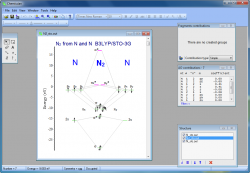
Chemissian
Chemissian is a powerful tool for analyzing the electronic structure and spectra of molecules. This tool allows the construction and analysis of molecular orbital energy-level diagrams using both Hartree-Fock and Kohn-Sham methods. Additionally, it enables the comparison of calculated and experimental UV-VIS electronic spectra on the same plot, as well as the calculation and visualization of spin natural orbitals, natural transition orbitals, and electronic and spin densities, preparing them for publication. The graphical interface of Chemissian is user-friendly, facilitating the examination and visualization of data from output files generated by various quantum chemical program packages, including Gaussian, US-Gamess, Firefly/PC-Gamess, Q-Chem, Molpro, NWChem, ORCA, Turbomole, and Spartan. Chemissian can be used to study the nature of transitions in UV-VIS spectra, as well as the bonding nature of molecules.
For the news, see the news page.
Chemissian Features:
Build Molecular Orbitals Energy Level Diagrams
- The integrated graphical editor facilitates the addition of text labels to MO diagrams. Connecting lines between MO energy levels can be added, and energy levels can be "occupied" with electrons. This makes it easier to visualize and analyze the molecular orbitals:

- Chemissian offers the ability to examine the electronic structure of molecules, including the option to navigate between energy levels using either a keyboard or mouse cursor. Additionally, Chemissian provides a clear visual representation of the contributions to the current molecular orbital from atomic or molecular fragments, presenting the information on either a contribution diagram or directly on the MOs diagram:
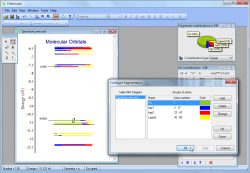
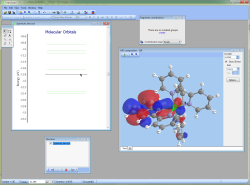
Build, Visualize, and Interpret UV-Visible Spectra from Gamess, Firefly, Gaussian, Spartan, Q-Chem, Orca, and NWChem Outputs
Chemissian provides a comprehensive graphical analyzer that can analyze the composition of MOs and electronic spectra of molecules. With a range of tools available, it is possible to build electronic UV/VIS spectra from output files generated by various quantum-chemical programs such as GAMESS, Firefly (PC-GAMESS), GAUSSIAN, Spartan, NWChem, Orca, or Q-Chem:
- It is possible to easily visualize a spectrum by simply loading the output of Gamess/Firefly/Gaussian/Q-Chem/Spartan/NWChem/Orca calculations that contain the TDDFT/CIS data.
- By displaying both experimental and calculated spectra on a single diagram with the same wavelength scale, a convenient comparison can be made.
- Multiple spectra can be included in one diagram, which is particularly helpful when examining the impact of the solvent on the spectrum.
- Similar to the MO diagram editor, the peaks in a spectrum can be navigated, linking the present peak with the transitions happening between MO levels:


- In Chemissian, the spectrum diagram can be customized by including text labels and various graphical objects. Different energy units can be used for convenience.
- With the assistance of Chemissian tools, it is possible to analyze and comprehend the nature of spectral transitions, such as metal-to-ligand charge transfer, ligand-to-ligand charge transfer, and pi-pi* transitions. This is achieved by utilizing the information of molecular orbital composition extracted from the output files of various computational chemistry software, including Gamess, Firefly, Gaussian, Q-Chem, Spartan, Orca, and NWChem.
- Calculating and visualizing natural transition orbitals:

Analyze Electronic Density Distribution
- With the help of Chemissian, the distribution of electronic and spin density, as well as the difference or "deformation" density, can be examined. Additionally, individual molecular orbitals can be analyzed, along with any linear combination of these variables, which can be useful for plotting Fukui functions and other related tasks:
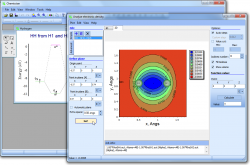
- Chemissian can build the distributions as three-dimensional surfaces,
- two-dimensional contour maps, or
- build the distribution along a given line (one-dimensional).
- For this, only the standard Gamess/Firefly/Gaussian/Q-Chem/Molpro (Molden)/Orca (Molden)/Spartan output file is used; no cube files are required.
Calculate Populations and Valences
- Chemissian can calculate Mulliken and Simple populations of atomic orbitals, shells, "spherical harmonics", and atomic or molecular fragments (any group of atoms):
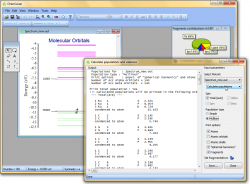
- It is possible to calculate valences of atomic orbitals, shells, "spherical harmonics", atoms, and fragments:
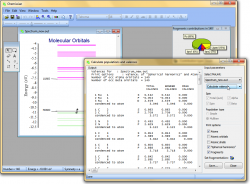
- Analyze molecular orbital composition by calculating contributions from atomic orbitals, atoms, molecular fragments, shells, etc., to MOs:
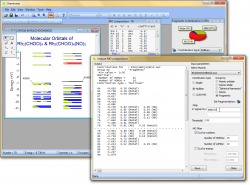
Calculate Quantum-Chemical Bond Order Indexes and Overlap Populations
- Chemissian can be used to investigate the bonding nature in molecules by calculating quantum-chemical bond order indexes and overlap populations for every bond in a molecule. It is also possible to analyze "generalized bonds," such as bonds between molecular fragments.

Work with Several Calculations at the Same Time
With Chemissian, it is possible to gather and analyze the results of multiple calculations in one document. For instance, when studying the starting reagents and the final reaction product, the changes in the electronic structure can be examined. Multiple calculations can be added to a single diagram, displayed on a shared energy scale. This feature allows for switching between different calculations and comparing the electronic structures of all participants simultaneously.
Save Results in a Single File
The obtained document can be saved in a Chemissian file format, which allows all data to be kept in a single compressed file (since uncompressed wave functions take up a lot of disk space). At any time, the saved document can be opened for further work, analysis, editing, and sharing with colleagues.
